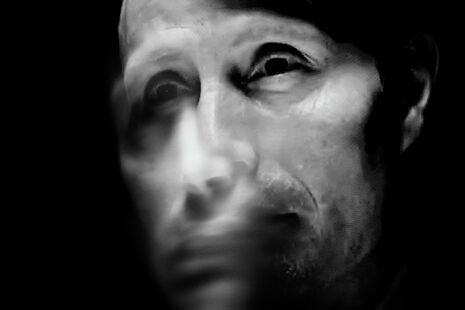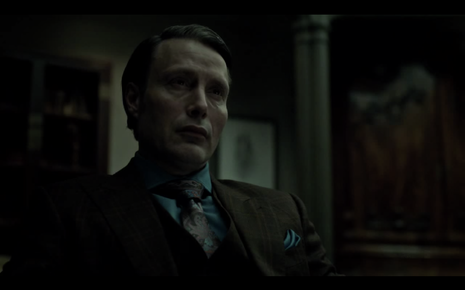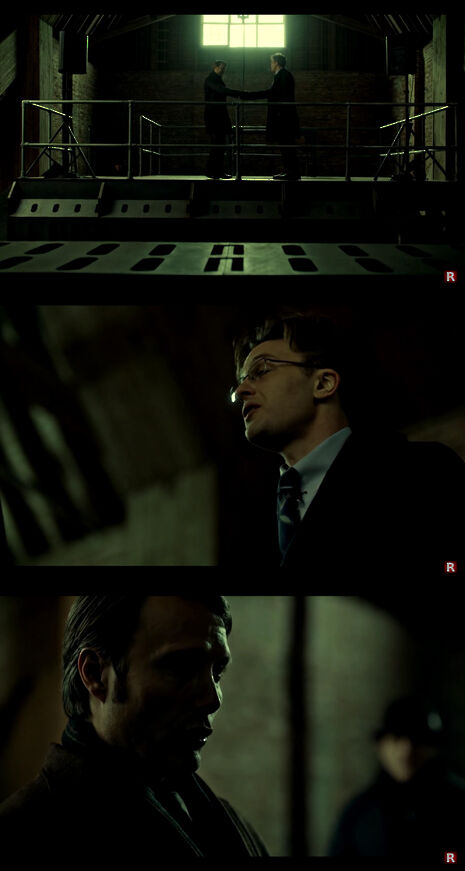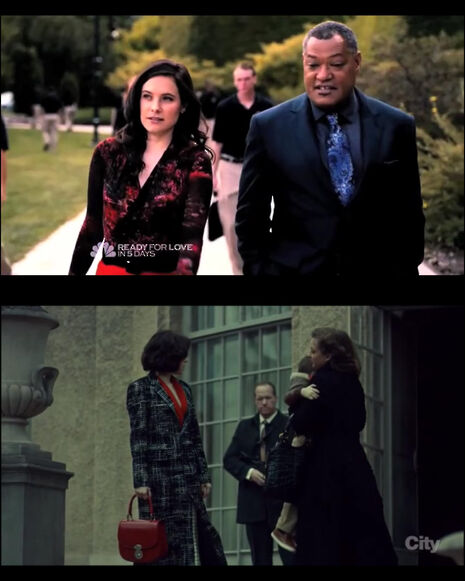Hannibal’s sartorial storytelling
Agustin Ferrari-Braun deciphers the codes behind a show that challenges the way fashion is usually used in movies and series

This summer I re-watched Brian Fuller’s Hannibal, which aired in the UK from 2013 to 2015. I often go back to series that I have already seen, but Hannibal is a particularly special case. Why? Because it’s mediocre.
Dr Hannibal Lecter is an appealing character but he lacks the charm needed to pull off an entire season. Mads Mikkelsen takes himself too seriously in the role of a psychiatrist who devotes his spare time to killing people he doesn’t like and eating them afterwards. The episodes of the first two seasons always feature a new case that needs to be solved while a wider story unfolds in the background – a narrative structure you may recognise from numerous other crime series. To put it simply, it is just another television thriller about murder.
So why do I come back to this show in particular? Well, since this article features in the fashion section, you can probably take a bold guess. Hannibal is a show that is all about aesthetics; it is a triumphant piece of art and fashion plays a key role. But don’t get me wrong; we’re not talking here about Sex and the City-type fashion where the characters are living look books. Dr Lecter, for instance, has a signature style (a three-pieced plaid suit teamed with an English spread collar shirt, a silk tie with paisley motifs and a silk pocket square) that no one would wear in everyday life due to its sartorial mix of baroque and absolute kitsch.

In the show fashion is first and foremost a subtle narrative device. Throughout its three seasons we become familiar with dozens of codes that tell us what to expect from the next minutes. For example, each time Hannibal doesn’t wear a tie, something bad is going to happen. Now there’s no way in which you could realise this before watching several episodes because every time he appears without neckwear, it’s in situations where having it would be seen as odd (a trip to the countryside, cooking at his house, swimming...). But once you have cracked the show’s cypher you know what it means and you know what Hannibal is plotting – a much subtler way to create complicity than asides to the camera, if you ask me.
Besides these small details, clothes also have a central place in the overall sense of the show. The visual importance of fashion is developed here as I have rarely seen elsewhere. One of the motors in the Hannibal narrative is the opposition between the main character and his rivals, who envy his success and want to take his prominent place as either a prestigious doctor, famous murderer or even mundane figure. A visual opposition always demonstrates this conflict. Frederick Chilton’s cane, Tobias Budge’s vests or Mason Verger’s tiepins and fur overcoats, every person who wants to replace Lecter at some point in the show will first challenge him from a sartorial point of view, presenting himself with an item of clothing that is both dandy-esque and absent from the protagonist’s wardrobe. This is a beautifully staged confrontation that lets both Hannibal and us as viewers know that conflict is imminent.

But what definitively makes Hannibal’s wardrobe extraordinary is how it expresses the relationship between the main characters. When the first season begins, all the characters but Lecter have an extremely conventional style that can be found in any other crime series. As the episodes unfold, Hannibal will try to change them, to bring them into his world both psychologically and sartorially. Jack Crawford, the head of the Behavioural Sciences Unit, preserves his dull suits paired with dark shirts and ties over the three seasons, showing his rejection of the cannibal lifestyle. Will Graham, the gifted policeman who can think like criminals and was described by someone on the internet as “the human incarnation of cargo pants”, has a more complicated relationship with his psychiatrist. He wears clean shirts when he becomes closer to him and fishing gear when he’s more distanced and passes through a wide range of outfits in-between those two extremes that reflect his psychological state.
Nevertheless, the most interesting aspect of the show is the transformation of Dr Alana Bloom, who fully enters the world of the cannibal. The first time she appears on screen, she wears a very professional outfit of black stilettos, a red below-the-knee skirt, a black belt and a burgundy blouse. By the time we hit the second half of the third season she’s in a double-breasted tailored red overcoat worn on top of a heavily plaid Prince of Wales suit with a criss-cross top, stilettos, leather gloves and a cane: a transformation that in any other universe would be treated like Sandy’s in Grease. Not here. It is just a logical development that progressively takes place throughout the three seasons.

An overcoat, a blazer, a piece of neckwear...for an aesthete like Dr Lecter those items always carry meaning. And, as we get to know him better and better, they start to carry meaning for us as well. By telling the entire story through the wardrobe of his characters, Brian Fuller makes us carefully examine the outfits that we see on the screen. And often what we see is dangerously similar to what Hannibal does. This series is not the only one that makes you embrace the perspective of a killer, but it is the only one that makes you enter the mind of such a twisted individual via his fashion sense. And that is why I keep coming back to Hannibal, because no other film or series has done with clothing what it managed to do during its three seasons of existence.
 News / Night Climbers call for Cambridge to cut ties with Israel in new stunt15 April 2024
News / Night Climbers call for Cambridge to cut ties with Israel in new stunt15 April 2024 News / Police to stop searching for stolen Fitzwilliam jade17 April 2024
News / Police to stop searching for stolen Fitzwilliam jade17 April 2024 News / Cambridge University cancer hospital opposed by environmental agency12 April 2024
News / Cambridge University cancer hospital opposed by environmental agency12 April 2024 Interviews / In conversation with Dorothy Byrne1 March 2024
Interviews / In conversation with Dorothy Byrne1 March 2024 Interviews / ‘It fills you with a sense of awe’: the year abroad experience17 April 2024
Interviews / ‘It fills you with a sense of awe’: the year abroad experience17 April 2024


